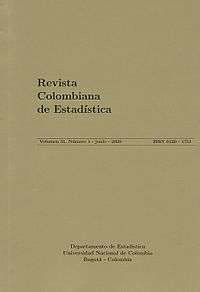Revista Colombiana de Estadística
The Revista Colombiana de Estadística (English: Colombian Journal of Statistics) is a biannual peer-reviewed scientific journal on statistics published by the National University of Colombia. It covers research on statistics, including applications, statistics education, and the history of statistics.
 | |
| Discipline | Statistics |
|---|---|
| Language | English |
| Edited by | Leonardo Trujillo |
| Publication details | |
| History | 1968, 1981–present |
| Publisher | National University of Colombia (Colombia) |
| Frequency | Biannually |
| 0.179 (2014) | |
| Standard abbreviations | |
| ISO 4 | Rev. Colomb. Estad. |
| MathSciNet | Rev. Colombiana Estadíst. |
| Indexing | |
| ISSN | 0120-1751 (print) 2389-8976 (web) |
| OCLC no. | 229174225 |
| Links | |
History
The Revista Colombiana de Estadística was established in 1968. During the first years, the journal only published papers in Spanish but since 1985 it also publishes papers in English.[1] The journal stopped publication between 1969 and 1979. In 1979, it was relaunched by Luis Thorin and since 1981 the publication has been continuous with two issues per year. Recently, since 2011 the Journal only publishes articles in English language.
Abstracting and indexing
The Revista Colombiana de Estadística is abstracted and indexed in Scopus, SciELO, Current Index to Statistics, Mathematical Reviews, Zentralblatt MATH, Redalyc, Latindex, and Publindex (category A1). According to the Journal Citation Reports, the journal has a 2014 impact factor of 0.179.[2]
References
- O. Soto (2004). "Reconstrucción de la memoria histórica del Departamento de Estadística de la Universidad Nacional de Colombia". Revista Colombiana de Estadística. 27 (1): 77–98.
- "Web of Science". 2014. Retrieved 2014-07-30.